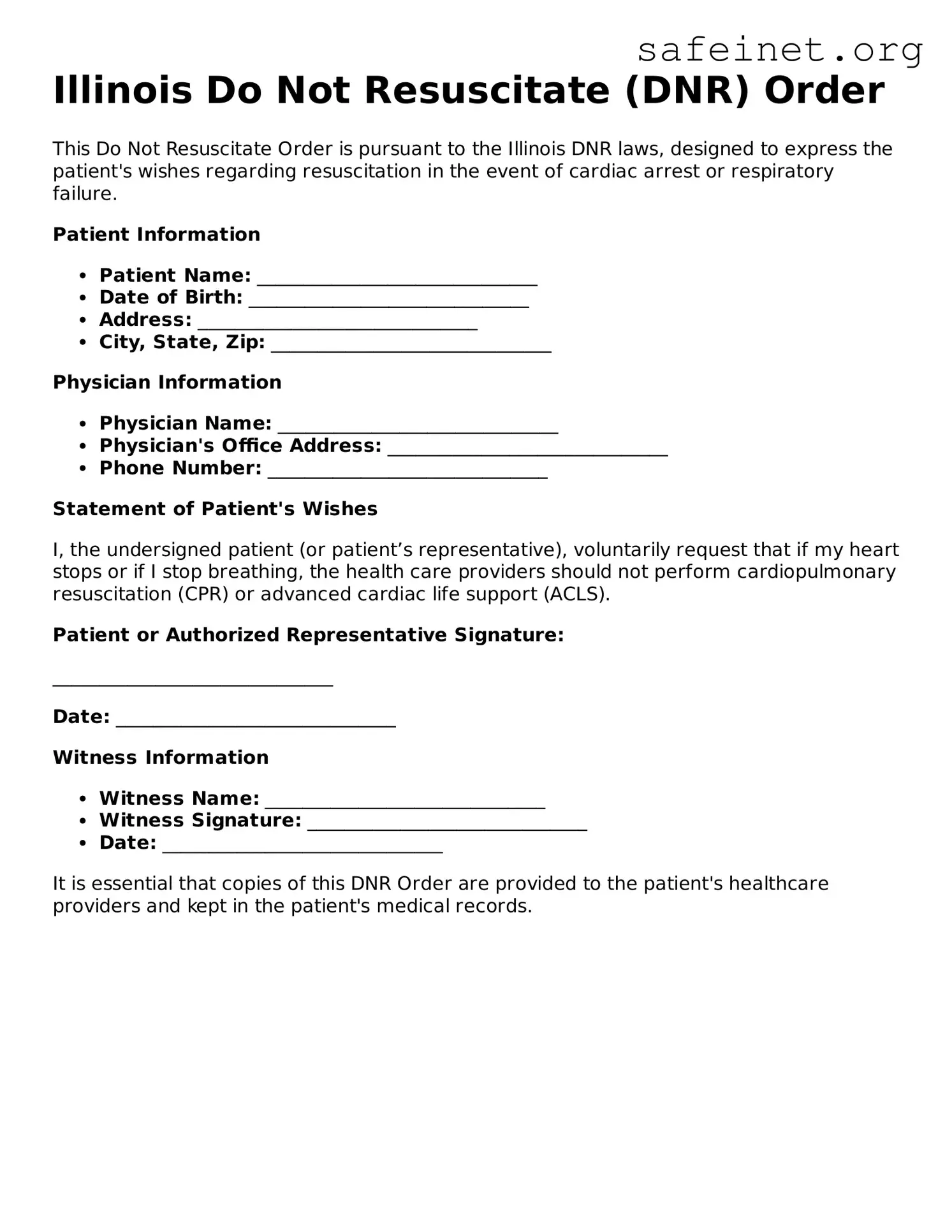The Illinois Do Not Resuscitate (DNR) Order form shares similarities with an Advance Healthcare Directive, which allows individuals to outline their preferences for medical treatment in advance. Both documents empower individuals to make decisions regarding their healthcare when they may no longer be able to communicate their wishes. An Advance Healthcare Directive often includes a broader scope of instructions compared to a DNR, which specifically focuses on resuscitation efforts. In both cases, the documents should be signed and witnessed to ensure they are legally binding.
Another document akin to the DNR Order is a Medical Power of Attorney. This legal tool designates a trusted person to make healthcare decisions on behalf of another if they become incapacitated. While the DNR specifically addresses resuscitation, a Medical Power of Attorney can cover a variety of medical choices, allowing for a more comprehensive approach to healthcare decisions. Both documents provide peace of mind, knowing that an individual's wishes regarding their care will be respected, even when they cannot voice them.
The Living Will is also similar to the Illinois DNR Order. This document conveys an individual’s preferences regarding end-of-life care, specifically in situations where they are terminally ill or in a persistent vegetative state. Like the DNR, the Living Will serves to ensure that medical providers understand the patient's wishes about life-sustaining treatments. It focuses on the quality of life and may overlap with the decisions about resuscitation, but its scope can be broader, addressing various scenarios that may not lead to resuscitation.
The Physician Orders for Life-Sustaining Treatment (POLST) is another document that aligns closely with the Illinois DNR Order. The POLST form is used to express a patient’s wishes about medical treatments, particularly for those with serious health conditions. Unlike the DNR, which is predominantly focused on resuscitation, the POLST encompasses a wider range of treatments, including intubation and feeding tubes. Both forms require the involvement of healthcare professionals to translate personal wishes into actionable medical orders.
A healthcare proxy is similar to a DNR Order because it designates someone to communicate healthcare decisions on an individual's behalf. The proxy is especially useful in critical situations where the patient cannot express their wishes. While the DNR directly states preferences about resuscitation, the healthcare proxy ensures that the appointed person understands those preferences and applies them in practice. This relationship between patient and proxy underscores the importance of trust in healthcare decision-making.
Palliative care orders are also comparable to the DNR Order. These orders emphasize relieving symptoms and improving quality of life rather than prolonged medical interventions. The DNR is often a part of a palliative care plan, as both focus on patients with serious illnesses who prefer comfort over aggressive treatments. While palliative care provides a holistic approach to treatment, the DNR specifies the patient's choices about resuscitation specifically.
Hospital Do Not Attempt Resuscitation (DNAR) orders are closely aligned with the Illinois DNR Order, sometimes used interchangeably. Hospital DNAR orders specify that resuscitation measures should not be taken if a patient's heart stops or if they stop breathing while in the hospital. This document serves to ensure medically appropriate responses to end-of-life situations, similar to the broader community-oriented DNR. Clarity in both forms is essential to prevent confusion among medical staff in critical moments.
Similar to the DNR Order, the Consent for Terminal Care emphasizes the patient’s wishes regarding treatment at the end of life. This consent form gives healthcare providers the authority to administer treatment that is in line with the patient’s preferences. Unlike the DNR, which focuses solely on stating a refusal of resuscitation, this form may authorize other forms of care, ensuring that loved ones and providers understand how to respect the patient’s desires during their final days.
Emergency Medical Services (EMS) DNR forms also exist, resembling the Illinois DNR Order. These forms are designed to inform emergency responders of a patient’s wish not to receive cardiopulmonary resuscitation (CPR). An EMS DNR is typically placed in a prominent location, such as on a refrigerator, or worn as a bracelet, ensuring that first responders are aware of the patient’s wishes from the onset of an emergency. Both documents aim to clearly communicate a person’s preferences so that medical teams can act accordingly.
Finally, a state's specific DNR registry is similar to the Illinois DNR Order. Many states maintain registries where individuals can file their DNR orders, ensuring better visibility among healthcare providers. The goal of both is to ensure that healthcare professionals are aware of a patient’s wishes for resuscitation without complications. In these cases, health professionals can access a centralized record, similar to how the Illinois DNR form communicates an individual's preferences in physical settings.
